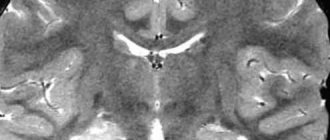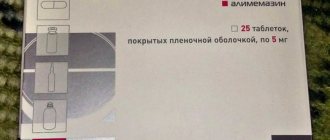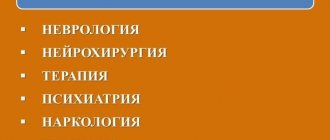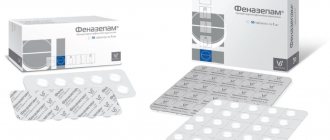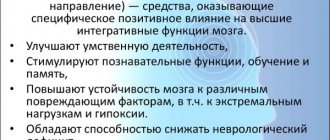Many antipsychotics exert their antipsychotic activity by blocking dopamine receptors. And the sedative effect occurs as a result of inhibition of the influence of norepinephrine in the reticular formation. Blockade of dopaminergic subcortical structures by these drugs leads to extrapyramidal disorders, which among specialists are called neuroleptic syndrome. Blocking dopamine receptors in the pituitary gland increases prolactin production, stimulating lactation. Changes in the hypothalamus delay the synthesis of corticotropin and somatotropin.
Effect on the body
The main pharmacological feature of antipsychotics is their antipsychotic sedative effect. It manifests itself in relaxation, restoration of emotional balance, and decreased excitability. In patients with psychotic disorders, hallucinations, automatisms, and delusional ideas fade away.
Antipsychotics do not have a pronounced hypnotic effect, but they can provoke a drowsy state, facilitate the onset of sleep, and increase the effectiveness of sedatives. Therefore, for example, the combination of “barbiturates + neuroleptics” causes excessive sedation and hypotension. The effect of analgesics and local anesthetics is also enhanced, but the effects of psychostimulants are reduced.
There are groups of antipsychotics with specific effects. Thus, aliphatic phenothiazine derivatives, for example, Aminazine, have a sedative effect, and piperazine phenothiazine derivatives (Prochlorperazine) have an activating effect. Some antipsychotics ease depression, reduce anxiety, and increase appetite.
Symptoms of antipsychotic poisoning
The main stages are the same as for poisoning with sleeping pills and tranquilizers.
Dry mouth, severe weakness, nausea, and dizziness are noted.
Convulsions and loss of consciousness are possible, the pupils are constricted, the reaction to light is reduced, and convergence is impaired. Blood pressure is reduced, pulse is increased. Skin allergic reactions.
From the nervous system: decreased tendon reflexes, muscle spasms, trismus of masticatory muscles, ataxia, convulsions. Severe hypomimia and hypokinesia without a significant increase in muscle tone.
Hyperkinetic syndrome - oral hyperkinesis, tremor of the hands, or the replacement of one hyperkinesis by another. The reaction to painful stimuli is preserved.
In a shallow comatose state - hypothermia, tendon reflexes are increased.
Diagnosis of a toxic substance in the blood is determined by the spectrophotometric method.
EEG.
The ECG shows sinus tachycardia, ST segment depression, negative T wave.
Indications for use
Antipsychotics are prescribed for mental and psychoneurological disorders accompanied by delusions, hallucinations, pseudohallucinations, illusions, thinking disorders, behavioral disorders, psychotic agitation, aggressiveness, and mania.
Sometimes these drugs are effective in treating depression, deficiency symptoms - pathological lack of will, apathy, emotional flattening, autism. A number of studies point to the fact that antipsychotics eliminate deficit symptoms by reducing delusions, hallucinations, or depression. The most common indications for the prescription of antipsychotics are diseases such as:
- schizophrenia
- bipolar affective disorder
- dementia with behavioral disturbances
- exogenous psychoses (alcoholic, stimulant)
- behavior disorders of excitable, hysterical type
- neurotic, neurosis-like disorders (in small dosages)
Traffic
| A country | Place in countries | Visitors % | Page views % |
| Russia | 8526 | 75.66% | 76.44% |
| Armenia | 29066 | 1.05% | 0.86% |
| Germany | 966973 | 0.77% | 1.18% |
| Russia, Armenia, Germany are the most popular countries. | |||
| Region | Place in the region | Visitors % | Page views % |
| Transbaikal region | 6053 | 0.47% | 0.18% |
| Jewish Autonomous Region | 6138 | 0.19% | 0.12% |
| Irkutsk region | 6309 | 0.9% | 0.92% |
| Yamalo-Nenets Autonomous Okrug | 6394 | 0.48% | 0.79% |
| Kabardino-Balkaria | 6565 | 0.8% | 0.37% |
| Altai | 6650 | 0.84% | 0.95% |
| Omsk region | 6820 | 0.53% | 0.86% |
| Astrakhan region | 6906 | 0.83% | 0.72% |
| Udmurtia | 7161 | 0.92% | 0.44% |
| Nenets Autonomous Okrug | 7502 | 0.98% | 0.52% |
| Moscow | 7588 | 0.21% | 0.97% |
| Amur region | 7673 | 1.03% | 0.34% |
| Vladimir region | 7843 | 0.77% | 0.18% |
| Tver region | 8014 | 0.97% | 1.01% |
| Saint Petersburg | 8526 | 0.83% | 0.21% |
| Yaroslavl region | 8611 | 0.3% | 0.78% |
| Bryansk region | 8696 | 0.73% | 0.9% |
| Volgograd region | 8781 | 0.81% | 0.17% |
| Stavropol region | 8952 | 0.44% | 0.34% |
| Chelyabinsk region | 9293 | 0.55% | 0.26% |
| Tomsk region | 9378 | 0.48% | 0.59% |
| Primorsky Krai | 9634 | 0.68% | 0.27% |
| Magadan Region | 9719 | 0.65% | 0.16% |
| Khanty-Mansi Autonomous Okrug - Yugra | 10060 | 0.97% | 0.83% |
| Kursk region | 10145 | 0.67% | 0.67% |
| Karachay-Cherkessia | 10316 | 0.12% | 0.47% |
| Sverdlovsk region | 10486 | 0.29% | 0.63% |
| Kamchatka Krai | 10572 | 0.48% | 0.7% |
| Kirov region | 10742 | 0.49% | 0.89% |
| Chechnya | 10828 | 0.2% | 0.35% |
| Adygea | 10913 | 0.44% | 0.75% |
| Average statistics for the last 3 months | ||
| Place in the world | 201,604 | -202 |
| Monthly attendance | 330,450 | 0.1% |
| Position by monthly traffic | 201,604 | -202 |
| Page views per month | 1,966,170 | -3% |
| Position by page views | 166,112 | +4,983 |
| Page views by 1 visitor | 5.95 | — |
Types of antipsychotic drugs
There are several classification options for antipsychotics. In clinical practice, the most common division of drugs is based on their leading action. There are three groups of antipsychotics:
- Sedatives. They have a predominantly sedative effect: they inhibit mental processes, eliminate anxiety, restore sound sleep, and relax skeletal muscles. Ineffective for delusions and hallucinations. This group includes Aminazine, Clozapine, Promazine.
- Antipsychotic. The main effect is a decrease in productive psychotic symptoms (delusions, hallucinations, motor, mental agitation). Neurological side effects are typical. Some of the drugs in this group have an additional sedative effect, while others, on the contrary, activate and increase disinhibition (the so-called “daytime” neuroleptics). Representatives - Haloperidol, Etaperazine, Droperidol, Sulpiride.
- Behavior correctors. As the name implies, the ability of drugs to stop behavioral disorders of the excitable, hysterical type comes to the fore. Prescribed for severe psychopathy and neuroses. When they are used, there is a decrease in temperament, demonstrativeness, and aggressiveness. This group includes: Periciazine, Thioridazine (Sonapax).
Typical and atypical antipsychotics
Typical or classical antipsychotic drugs are called the first generation of antipsychotics. They have a high degree of affinity for dopamine D receptors and do not bind to receptors of other types. They have a pronounced antipsychotic effect and a high risk of developing extrapyramidal disorders. Typical antipsychotics are Chlorpromazine, Alimemazine, Periciazine.
Atypical antipsychotics are new generation drugs that have a low degree of affinity for dopamine D2 receptors and are able to bind to other receptors (serotonin, norepinephrine). They are “milder” and better tolerated, but, according to some researchers, they are less effective against negative psychotic symptoms. Atypical antipsychotics – Clozapine, Olanzapine, Risperidone, Asenaline.
Neuroleptic syndrome
Particular attention should be paid to the most common complication during the period of taking antipsychotics. It occurs when a person takes the medicine for a long time or uses the medicine incorrectly. In some patients, the cause of a negative reaction is an individual reaction to the drug.
Against the background of constant exposure to dopamine receptors of extrapyramidal structures, neuroleptic syndrome appears. Signs of this deviation are:
- increased muscle tone
- stiffness and slowness of movements
- slurred speech
- lethargy and drowsiness
- disruption of memory and thinking processes
- difficulty breathing, swallowing
Severe manifestations of neuroleptic syndrome can lead to death if help is not provided in time. The development of complications is minimized when a person strictly adheres to the doctor’s recommendations during therapy. Treatment of the problem consists of prescribing corrective drugs. In order to reduce the likelihood of side effects and the appearance of drug-induced parkinsonism, anticholinergic drugs are used. Sometimes doctors recommend beta blockers, antihistamines, and substances that stimulate dopamine production to eliminate the problem.
Vacation without a doctor's prescription
There are very few antipsychotic drugs available without a prescription .
At the moment, the supply of such drugs is very strictly controlled by the state as part of the fight against drugs.
This is controlled by the “List of narcotic drugs, psychotropic substances and their precursors subject to control in the Russian Federation” of 1998.
Purchasing or storing drugs without a valid prescription from this list is punishable under Article 228 of the Criminal Code of the Russian Federation .
However, there are medications that can be bought without a prescription.
These are Etaperazine, Paliperidone and Chlorprothixene .
Despite the free supply of these drugs in pharmacies, we would not recommend that you self-medicate, but consult with a specialist.
Source: psychoholic.ru
Treatment of poisoning with neuroleptics
Emergency care for poisoning with antipsychotics:
1. Gastric lavage through a tube, followed by the introduction of activated carbon, emetics.
2. Infusion therapy, forced diuresis without alkalization of the blood.
3. Detoxification hemosorption.
4. Correction of hemodynamic and respiratory disorders.
5. Anticonvulsant therapy.
7. Diphenhydramine 2-3 mg/kg IV or IM to suppress extrapyramidal symptoms.
Read also: Toadstool poisoning - symptoms, first aid
Complications - see “Poisoning with sleeping pills and tranquilizers.”
Patients require long-term observation and treatment. Asthenic syndrome can persist for 2-3 years after intoxication.
Is it possible to overdose
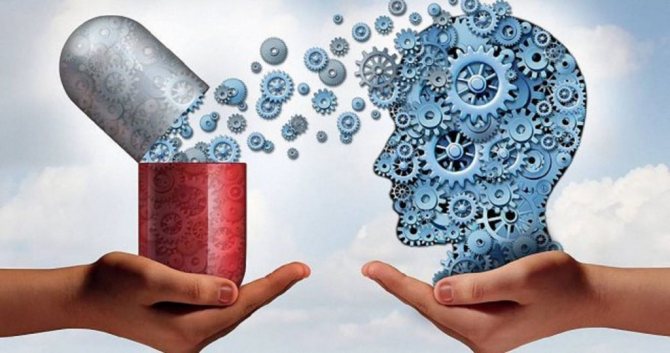
Yes, if you exceed the concentration of the drug, an overdose cannot be avoided. In this case, the side effects of antipsychotics are much more pronounced. Plus, threatening signs of a pathological condition appear:
- Impaired consciousness. If the concentration of a substance is several times higher than permissible, stupor or coma is almost guaranteed.
- Heart rhythm disturbances. Both tachycardia and bradycardia are possible.
- Other forms of arrhythmia. Life-threatening.
- Respiratory disorders.
- Increased hallucinatory and delusional symptoms. What antipsychotics are designed to combat.
To prevent dangerous consequences, you must strictly follow the dosage prescribed by your doctor. Poisoning with antipsychotics can lead to death or severe disability.
Diagnosis of poisoning with neuroleptics.
An integral part of the diagnosis of poisoning with antipsychotics is the collection of a toxicological history. The survey is carried out according to the situation, either from the patient himself or from eyewitnesses of the incident. It is necessary to obtain information about the drugs used, the name of the drug, dose and time of use.
Read also Alkali poisoning - caustic soda, caustic potassium, slaked lime, mole
In laboratory conditions, a chemical and toxicological study of blood and urine is carried out as quickly as possible in order to establish and confirm a clinical diagnosis. The study includes qualitative and quantitative determination of the drug in the body.
The presence of alcohol in the blood and urine enhances the narcotic effect of the drug, as a result of which its determination is mandatory.
